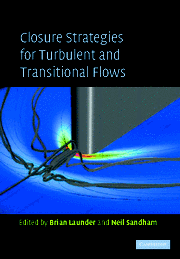2 - Second-Moment Turbulence Closure Modelling
Published online by Cambridge University Press: 06 July 2010
Summary
Introduction
Differential second-moment turbulence closure models (DSM) represent the logical and natural modelling level within the framework of the Reynoldsaveraged Navier–Stokes (RANS) equations. They provide the unknown secondmoments (turbulent stresses uiuj and turbulent fluxes of heat and species, θuj) by solving model transport equations for these properties. Hence, instead of modelling directly the second-moments, as is done with eddy-viscosity/diffusivity schemes, the modelling task is shifted to unknown higher-order correlations which appear in their differential transport equations.
The main advantage of DSM is in the exact treatment of the turbulence production terms, be it by the mean strain or by body forces arising from thermal buoyancy, rotation or other forces. In addition, the solution of a separate transport equation for each component of the turbulent stress enables, in principle, an accurate prediction of the turbulent stress field and its anisotropy, which reflects the structure and orientation of the stress-bearing turbulent eddies and, thus, plays a crucial role in turbulence dynamics in complex flows. This role can be identified in the process of turbulence energy production, particularly if pure strain (compression and dilatation) is dominant such as in stagnation regions, or in energy redistribution and consequent enhancement or damping e.g. in rotating and swirling flows. Stress anisotropy is an important source of secondary motion, and plays a role in controlling the dynamics of longitudinal vortices. Accurate prediction of the wall-normal stress component is also important in reproducing the wall phenomena, such as the wall shear stress or heat and mass transfer. Further, capturing stress anisotropy also enables a more realistic modelling of the scale-determining equation (dissipation rate or other variable).
DSMs have long been expected to replace the currently popular two-equation k-ϵ and other eddy viscosity models as the industrial standard for Computational Fluid Dynamics (CFD). However, despite more than three decades of development and significant progress, these models are still viewed by some as a development target rather than as a proven and mature technique for solving complex flow phenomena. Admittedly, DSMs do not always show superiority over two-equation EVM models. One reason for this is that more terms need to be modelled. While this offers an opportunity to capture the physics of various turbulence interactions better, the advantage may be lost if some of the terms are modelled wrongly.
- Type
- Chapter
- Information
- Closure Strategies for Turbulent and Transitional Flows , pp. 47 - 101Publisher: Cambridge University PressPrint publication year: 2002
- 14
- Cited by



